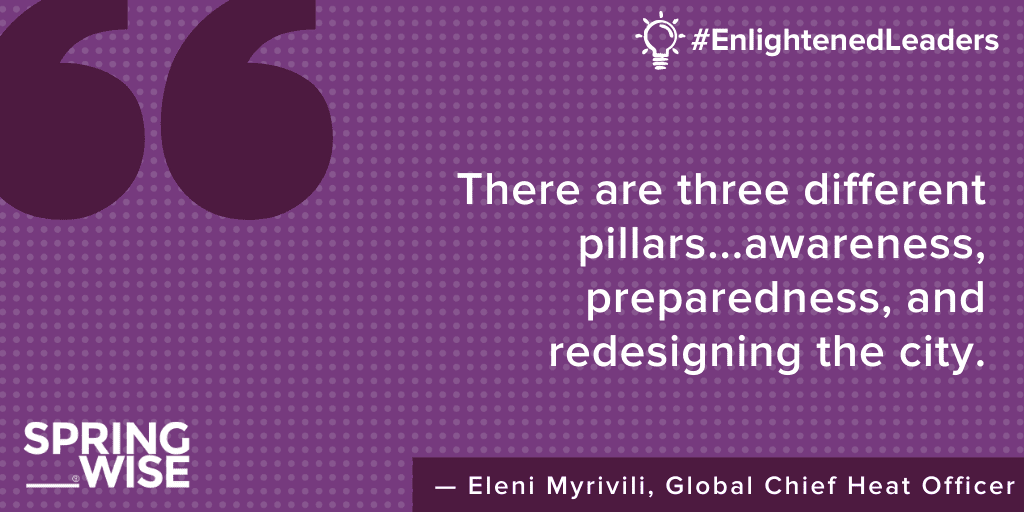Eleni Myrivili is the Global Chief Heat Officer for UN Habitat, the United Nations Human Settlements Programme, which facilitates more socially and environmentally sustainable towns and cities. It is currently active in more than 90 countries to promote transformative change through knowledge, policy advice, technical assistance and collaboration.
In addition to her role for the UN, Eleni is a senior adviser for resiliency and sustainability to the City of Athens. She was an elected official in Athens for a number of years, pioneering work on heat adaptation before becoming Chief Heat Officer for the city in 2021, a position championed by the Arsht-Rockefeller Foundation.
We spoke to Eleni two weeks into the devastating heatwave affecting Greece and other countries around the world, and ahead of a weekend where temperatures in Athens could reach 45 C…
Interview
“It doesn’t seem to be ending and we are talking about 40 degrees, 41 degrees, 44 degrees…And I hate air conditioning, I don’t have it in my home – and I work from home.” Eleni is talking to us via video call from her home in Athens, and while the white walls and comfortable looking white sofa suggests a cool environment, her face tells a different story. “It’s just unbearable.”
In her TED talk from last year, she signs off by saying, “Cranking up the air conditioner is just not going to cut it.” Indeed, air conditioning and fans account for around 20 per cent of global electricity consumption, and contribute around 1.95 million tonnes of carbon emissions annually.
“I’m working together with the Cool Coalition led by UNEP to put together a pledge on a national level that has to do with active cooling and how can we make sure we don’t end up with thousands of air conditioning units throwing our mitigation goals out of the window,” she says.
Eleni is a passionate advocate for the need to reintroduce green spaces, planting, and areas of surface water to our urban environments, which all promote passive cooling. “Landscape architecture I think will change the world,” she laughs. It’s a moment of light relief. The conversation is taking place while wildfires continue to devastate the countryside surrounding Athens and the heat indoors is clearly debilitating.
The strategy

To try and cope, the city is implementing strategy that Eleni put in place. “There are three different pillars with actions that have to do with awareness, preparedness, and redesigning the city.”
A big part of the awareness pillar centres around categorisation of heatwaves. “It is an important thing and an initiative that we have tried in a couple of cities, but it’s something that all cities should try to do,” she says.
The categories are not set by a central body, such as the World Meteorological Organisation, rather each city categorises its own heat. “What you do is gather data from decades prior to now – temperature and other parameters such as humidity, winds, and atmospheric pressure to create the typologies that usually form the air masses that sit on top of your cities. You then check mortality rate data and see which typologies make the mortality rate peak. It allows you to create an algorithm that is very specific to your city.
“So now we are doing five or six cities in Greece – they each have their own algorithm because they all have their own relationship between heat and health. I hope the formula we use will soon be open IP – The Arsht-Rockefeller Foundation is exploring how the IP can be opened up so that different universities can use it.”
The different categories from one to three offer an estimated number of excess deaths that would be likely due to the extreme heat. Human health can be affected by heat in a number of ways, both physical and mental. In the vulnerable, it can be fatal.
As part of the preparedness pillar, categorisation allows people who work with vulnerable groups: the elderly, the very young or the homeless, to share information with them that will keep them safer in the heat, to ensure that they are being checked on, or taken to cooling centres.
It’s ultimately the third pillar, redesign, that will have a longer-term impact on how people are able to live and work in cities in a world where temperatures continue to rise. But the challenge there is a financial one. Eleni is clearly frustrated: “The budgets countries have for cities is miniscule. The maximum amount a country can get from the climate change Adaptation Fund is around $20 million and how many cities does a single country have?”
She sighs “Who knows? Maybe these crazy heat waves, now that the whole northern hemisphere is under extraordinary heat conditions… Maybe this will create the momentum we need to have something move forward fast in terms of adaption funding?”
Let’s hope so. Funding will be on the agenda at the upcoming COP28 conference in Dubai (30 Nov to 12 Dec). We will be publishing more on how cities and societies are innovating to mitigate for and adapt to extreme heat, and the role Chief Heat Officers are playing, over the coming months in the run up to COP28.
Words: Angela Everitt

